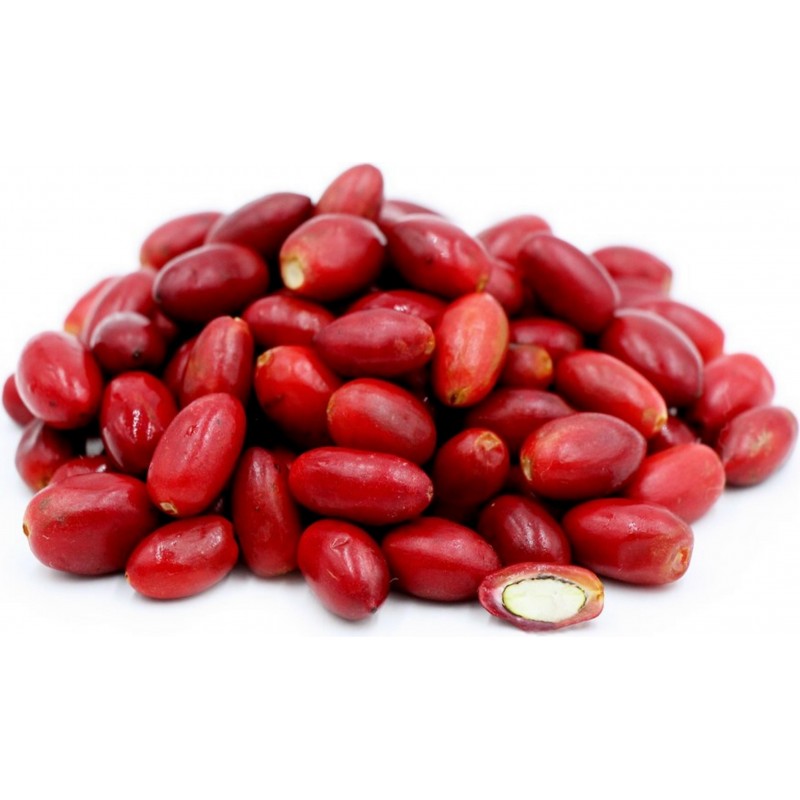









Mirakelfrukt växer på en buske som kommer från Västafrika. Bäret smakar svagt sött, men innehåller inte mycket socker. Busken som bäret växer på blir mellan 1,8-4,5 meter hög. Bären är röda, 2 cm långa och varje
Mirakelfrukt växer på en buske som kommer från Västafrika. Bäret smakar svagt sött, men innehåller inte mycket socker. Busken som bäret växer på blir mellan 1,8-4,5 meter hög. Bären är röda, 2 cm långa och varje frukt innehåller ett frö.
Bäret innehåller ämnet miraculin som ger bäret dess unika effekt. Om man äter bären och sedan äter något surt, så smakar det sött! Den får alltså sur mat att smaka sött. I USA kunde man fram till 1970 köpa tabletter med ämnet, det var ett tag vanligt med ”miraculin party” där man man samlades och åt bären ihop med citron, rädisor, saltgurka, chilisås och öl för att uppleva smakskillnaderna. Ämnet miraculin produceras nu genom modifiering av tomatplantor.
I Västafrika där växten härstammar ifrån används växten för att söta palmvin. Den används också för att skapa god smak på majsbröd som blivit surt. I Japan är bäret populärt bland diabetiker och personer som går på dieter.
The miracle fruit, Synsepalum dulcificum, is one of the strangest tropical fruits grown by Rare Fruit Council members and other hobbyists. This small, evergreen shrub, native to tropical West Africa, grows slowly to a height of 12 to 15 feet. The most unusual thing about the fruit is the effect it has on one's taste after it has been consumed.
The 3/4-inch, bright scarlet berries are borne throughout the year, beginning when the plants are about four years of age. Most of the fruit is taken up by a single large seed, but the yellowish pulp around it can be nibbled off and then for the next hour or so, anything one eats that is sour has a sweet flavor, as if sugar has been added.
Miracle fruits like rich, well-drained soils that are acid in pH. On alkaline soils they often are grown in large containers with generous amounts of peat moss for sustained success in fruiting. Plants should be located where they get as much light as possible and should be fertilized every two to three months with a good quality balanced fertilizer. They like to be watered once or twice a week, or more often if they are in very sandy soils.
When plants are small they are subject to damage by frost, so they should be container-grown and kept indoors or moved to protected locations when frost or freeze threatens. Older plants may sustain some leaf and minor twig damage, but can sustain temperatures down into the mid-20's (°F) without being killed.
The interest in miracle fruit is such that almost anyone who has a plant always finds eager volunteers to test its sweetening properties. The fruits themselves are of interest as a commercial source of artificial sweetener; however, large quantities of berries are needed to collect a substantial amount of the sweetener.
When propagating miracle fruit, sow the seeds in a rich, well-drained medium, just barely covered, and water lightly every other day. Seeds generally come up in about eight to ten weeks, but grow slowly the first year, often being only two to three inches tall at the end of almost one year of growth. It really takes three to four years before the plants reach a height of more than fifteen to twenty inches, and then they start to grow more rapidly.
There are few insects or disease pests associated with the miracle fruit, and since it is so easily containerized, almost anyone can grow this plant whether they have an outside planting area or not. In fact, many northern seed companies regularly offer miracle fruit seed for sale throughout the United States so that people may grow it indoors.
Datablad